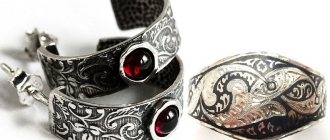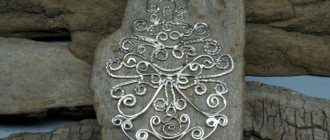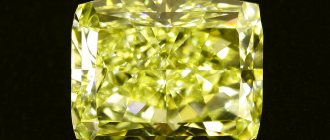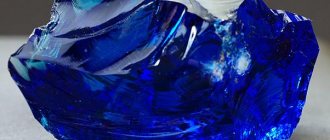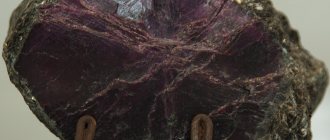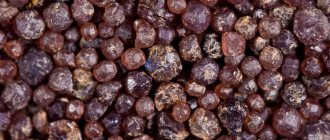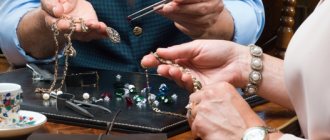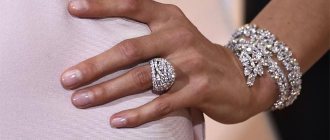Filigree
You've heard the word "filigree" and always associated it with the meaning of "particularly careful" and "attentive to detail." You are absolutely right.
Filigree is a jewelry technique that is used by experts to create patterns from thin silver or gold wire. Filigree patterns can be in the form of herringbones, ropes, weaving and other patterns. This jewelry work is done under a microscope.
The term "filigree" has Latin roots. It comes from the words filum - “thread” and granum - “grain”. There is also a native Russian analogue - filigree jewelry technology. This word comes from the Old Russian “s’kati”, which means “to twist” or “to twist”.
Filigree is found both in jewelry and in boxes, vases and even on the hilts of ancient swords.
If you see a similar pattern on a piece of jewelry, you know that it is filigree.
Jewelry casting is the most used production technology
Jewelry casting, as a rule, is carried out like this: several dozen wax models - like a kebab on a skewer - are assembled and soldered onto one thick rod. The result is a jewelry “Christmas tree,” which is carefully molded into special clay and baked. For high-quality casting of jewelry, it is necessary that the clay sinter and dry evenly, without a single crack, and then all the wax melts and flows out. The goal is to obtain a form with voids. Next, the thoroughly mixed alloy is poured into the mold. Afterwards everything is cooled, soaked and the clay is removed and the finished Christmas tree in metal is taken out. Products from it are “bitten off”. Now assemblers (of course, jewelry makers) are invited to the stage.
Jewelry cast using this production technology most often consists of several parts. They are fastened by assemblers. The parts are assembled together and soldered into one whole, the rings are adjusted to the required size, casting flaws are cleaned out and, in general, the product is given a marketable appearance. If the installer did not fail, then the decoration will not fall apart during wear.
Jewelry casting: grinding and polishing of products
Before the stone is mounted into the product, the jewelry is ground and polished. Grinding evens out the surface profile. Polishing (on soft felt) gives the surface a mirror shine.
Tumbling is a combination of polishing and grinding. Products are polished by mixing them in a drum with abrasive. Abrasive compositions range from nut shells to high-tech plastics. Although the quality of the product with tumbling is lower than with sequential polishing and grinding, this method is quite fast and cheap. Most of the jewelry of mass production technology (silver products, stamped gold products and inexpensive jewelry of the cubic zirconia group) are processed only by tumbling.
Setting stones in jewelry after casting
Jewelry with stones requires their setting. The fixer places the stones in the grooves and seals them so that they do not fall out. Stones, for the most part, are very fragile. They may not withstand the loads during the fastening process and may chip. For cheap cubic zirconias this is not a problem, but a chip of a large diamond can be very... upsetting. It is not surprising that enterprises, as a rule, do not work with customer’s stones, and the setter must be a true ace.
Automated jewelry manufacturing technologies
The more carefully all stages are completed, the better the final product. And the more expensive it is. If the price of the work exceeds the cost of materials, the buyer goes on strike. Therefore, jewelers resort to automation of production.
Let's say, hand-knitting chains is an extremely routine matter. The jeweler pulls the gold wire of the required thickness, cuts the links and begins weaving. Work will be more valuable than gold. But there are (maestro - music!) chain knitting machines. They are created for different types of weaving and can knit chains from several types of wire at once. The cost of a machine hour is much lower than that of a person, and the speed of work is higher. The chains are knitted in dozens of meters, cut into pieces of the required length and sent for sale.
Diamond cut
This is a modern technique for processing precious metals. Its principle is that gold and silver are processed at a special angle by special cutters at different depths. After applying a diamond facet to the jewelry, the finest patterns are obtained that sparkle in any light, like real diamonds.
Methodological development Frosty patterns using filigree technique
Article for MK “Jute Filigree” Methodist of SUT Sidorenko O.G.
An openwork filigree pattern, Frost sculpted on the glass... The landscape on the foggy screen, Did not give peace to the soul... Where does such art come from, Known to the night masters. Masterpieces told us what instrument to use skillfully...
The openwork filigree pattern caught my eye with magic. The twinkling stars beckon, The divine ice ball...
Vladimir Sergeev
The most beautiful filigree works of craftsmen, knitted from the finest metal threads, froze like frosty patterns on the windows. Take a closer look, they harmoniously combine antiquity with modernity, and the breath of centuries is not an anachronism, but a wonderful touch, an irreplaceable detail of the product. And this is not magic at all, but just filigree.
We call filigree something skillfully made, with special care and great attention to small details. What is filigree in the truest sense of the word?
This technique, which originated in ancient times, has remained almost unchanged to this day.
Filigree is one of the most elegant jewelry techniques, which is based on the use of openwork patterns. These are the most delicate and sophisticated jewelry in the world, which attract attention and amaze with their beauty.
The name of the technique is taken from the Greek language. The term “filigree” is derived from two Latin words: “phylum” - thread, and “granum” - grain. But the term “skan” originates from the ancient Slavic verb “skati” - to twist, twist. Therefore, in the domestic space, filigree is still called “filigree”. Both names indicate the features of this type of metal processing.
The homeland of filigree is ancient Egypt, but filigree art spread so quickly throughout the world that historians now call a large group of peoples the authors of filigree - the ancient Egyptians, the ancient Greeks, the Etruscans.
The filigree technique came to Rus' from Byzantium in the 9th-10th centuries. It was used for forging all kinds of products: frames for icons, book bindings, caskets, chests, etc.
Nowadays there are filigree traditions almost all over the world. This is especially observed in Russia, the Mediterranean, and Portugal. The filigree technique is known in the Balkans and Transcaucasia. Each region brings its own characteristics to the composition of products and technique, so it is not difficult for specialists to distinguish, for example, Maltese filigree from Bulgarian or Russian.
The filigree is supplemented with grain. Grain is small metal balls that enrich the product.
But before they learn how to work with wire, future craftsmen learn to work with such a pliable material as jute.
Perhaps this is how the name jute filigree appeared. Jute filigree is based on the same principles as metal filigree.
Jute filigree is one of the new modern techniques. This is an unusual and interesting handicraft that appeared relatively recently, thanks to our craftswomen, but has gained its popularity quickly and for a long time. A simple process, but the product nevertheless turns out to be extremely elegant. The possibilities for using environmentally friendly material are unlimited. The jute filigree technique allows you to reproduce incredibly elegant patterns. The entire creative process from concept to implementation passes through the soul and hands of the master.
An excellent material for creativity that can be bought at any hardware store. Jute twine can be used not only as an accompanying material, but also as the main and only one for creating products. It is flexible, easily deformable and keeps its shape.
Products with filigree
include a wide variety of materials: precious stones, enamel,
wood
, carved bone.
Filigree is often combined with enamel, including enamel, engraving, and embossing.
A glassy coating that is highly durable and applied to a metal base is enamel. Enamel came to Russia from Byzantium, so the Russian name for enamel is “ enamel.”
" - comes from the Greek "fingitis", which translates as "brilliant light stone, And from Wed. - Greek - “I mix.”
Wood filigree is an inlay with wood shavings. An ancient technique used in the 15th century to decorate icons was forgotten. Since 1990, Vladimir Valentinovich Tsekunov, a Gomel woodworker, took up its revival. He created the original technology, which he developed and brought to life. This method of decoration received such names as “Belarusian filigree”, “Sozhskaya filigree”, “Tsekunov’s filigree”. This technique can be considered a twentieth-century discovery in the arts and crafts. The lace pattern is laid out with shavings of different types of wood.
The technique of making stranded filigree is a unique phenomenon. It is relatively simple, but requires a lot of patience and care. The only school in the world is located in Gomel.
The non-jewelry industry also includes paper filigree. Translated from English, “quilling” means “bird feather.”
Filigree paper lace originated in Europe in the late 14th and early 15th centuries. The monks created elegant medallions by twisting paper with gilded edges onto the tip of a bird's feather.
What can you do with paper filigree? All!!!
The old traditions of filigree art are reflected in modern schools. The ancient art of hand-made filigree is widely practiced in our modern times.
4
Enamel
The word has Greek roots and means “I mix.” In jewelry, enamel is the creation of designs on enamel. Jewelry enamel is not ordinary. It consists of transparent or opaque lead glass that covers the products.
Enamel is used on crosses, images of saints, icons and other similar objects. This is an excellent decoration that ensures longevity of jewelry.
It is thanks to enamel that icons are stored for so long that after hundreds of years they retain their original qualities and become antique.
Blackening
The word “blackening” itself already describes the process and result of the artistic technique. It consists in applying a special mixture (niello) to the relief of the jewelry.
The result is an effect that creates a contrast between the color of the precious alloy and the black mass inside it. Blackening gives the jewelry a special beauty and protects the jewelry from chemical influences.
The most popular metal for blackening is silver. Sometimes jewelers also blacken gold, but do not carry out such treatment with other precious metals.
Handmade jewelry
The book examines in detail practical techniques for making jewelry without the use of devices, equipment and technologies inherent in mass production. The tools and devices necessary for hand-made jewelry are described. Safety rules are outlined. The book is intended for workers in the jewelry industry and arts and crafts.- About the book
- Preface
- Introduction
- Chapter 1. Materials for making jewelry 1.1. Precious metals
- 1.2. Precious metal alloys
- 1.3. Non-ferrous metals
- 1.4. Non-ferrous metal alloys
- 1.5. Other metals
- 1.6. Gems
- 1.7. Semiprecious stones
- 1.8. Ornamental stones
- 1.9. Organic stones
- 1.10. Artificial stones
- 1.11. Glass
- 1.12. Plastics
- 1.13. Bone, horn
- 1.14. Wood, textiles, leather, porcelain, rubber, papier-mâché, enamel, varnishes
- 1.15. Acids
- 1.16. Alkalis and salts
- 1.17. Pastes
- 1.18. Refractories
- 1.19. Adhesives
- Chapter 2. Tools and devices for making jewelry by hand
- 2.2. Cutting tool
- 2.3. Bending and straightening tool
- 2.4. Soldering tool
- 2.5. Tools for grinding and polishing, matting and brushing
- 2.6. Tool for securing inserts
- 2.7. Adaptations
- 2.8. Mass measuring equipment - scales
- 2.9. Jeweler's workplace
- Chapter 3. Handmade jewelry making operations
- 3.2. Bending and straightening
- 3.3. Soldering
- 3.4. Filing
- 3.5. Sawing with a jigsaw
- 3.6. Drilling
- 3.7. Scraping
- 3.8. Pinning
- 3.9. Whitening
- 3.10. Annealing
- Chapter 4. Classification, assortment, design of jewelry, jewelry fashion
- 4.2. Assortment of jewelry
- 4.3. Jewelry design
- 4.4. Jewelry fashion, modern jewelry
- 4.5. Technical requirements for jewelry, care for them
- Chapter 5. Making jewelry parts
- 5.2. Making tires
- 5.3. Making castes
- 5.4. Making welts
- 5.5. Making earrings
- 5.6. Making locks
- 5.7. Manufacturing of hinges
- 5.8. Making hooks
- 5.9. Making loops
- 5.10. Making a stand
- 5.11. Making ears
- 5.12. Making grain
- 5.13. Fitting jewelry parts
- Chapter 6. Jewelry Making
- 6.2. Making earrings
- 6.3. Making brooches
- 6 4. Making pendants
- 6.5. Making chains
- 6.6. Making bracelets
- 6.7. Making hairpins
- 6.8. Making medallions, chokers, necklaces, cufflinks, tie clips
- Chapter 7. Securing inserts
- 7.2. Types of fastening of inserts
- 7.3. General principles and features of insert fastening technology
- 7.4. Type of defect during fastening
- Chapter 8. Finishing operations
- 8.2. Sanding and polishing
- 8.3. Matting and brushing
- Chapter 9. Decorative processing of jewelry
- 9.2. Engraving
- 9.3. Enameling
- 9.4. Blackening
- 9.5. Oxidation
- 9.6. Electroplating
- Chapter 10. Filigree technique
- 10.2. Examples of making filigree jewelry
- Chapter 11. The concept of samples, assay supervision, stamps
- 11.2. Assay supervision
- 11.3. Stamps
- Chapter 12. Safety precautions, occupational hygiene, industrial sanitation
- 12.2. Occupational health
- 12.3. Industrial sanitation
- Bibliography
- 2.1. Measuring tool
- 3.1. Marking
- 4.1. Classification of jewelry
- 5.1. Manufacturing of overlays
- 6.1. Making rings
- 7.1. Types of stone cuts
- 8.1. Understanding Dimensional Accuracy
- 9.1. Coinage
- 10.1. Types and elements of filigree
- 11.1. Samples
- 12.1. Safety precautions when making jewelry by hand
Source: Novikov V.P., Pavlov V.S. 'Handmade jewelry' - St. Petersburg: Politekhnika, 1991 - p.208
Engraving
Engraving is the application of a design, ornament or inscription to a piece of jewelry. The engraving result is always in relief. One part of the pattern has a recess, and the other is convex.
Previously, every jeweler applied engraving using special cutters. This work was long and difficult. Microscopes have simplified the process somewhat, but not to perfection.
Nowadays all major jewelry companies do 3D engraving. Its essence is as follows. Designers give programmers the design they want to see in the image. The developers write a special program, thanks to which lasers apply the desired pattern in a matter of seconds.
You can talk endlessly about how hand engraving is done with passion, but you must agree: in any case, the program applies the edges with maximum precision. The end result is that you are wearing a perfectly engraved piece of jewelry.
Jewelry techniques: types and features (part I)
When creating jewelry, craftsmen use different techniques. Tinting the surface of a product, working with line and contour, working with color - there are many amazing techniques that we will talk about in our blog.
Tinting, coating the surface of jewelry, allows you to create unusual decorative effects, change the color of the jewelry and add shine to it. Since the 19th century, the most common method of tinting a product has been electroplating: a coating is applied to jewelry by depositing metals from salt solutions under the influence of an electric current.
There are several types of coatings:
- Gilding is the application of a thin layer of 999.9 fine gold to the surface of a piece of jewelry using electroplating: pure gold is applied to the piece of jewelry by depositing metals from salt solutions under the influence of an electric current.
- Silvering is the application of a thin layer of 999.9 silver to the surface of a product. Coated with an additional layer of silver, the product acquires a bright color and becomes more resistant to external influences.
- Oxidation is the process of covering a silver product with a uniform sulfide film, due to which the silver acquires an interesting shade with dark and light color transitions, allowing you to focus on the relief of the product. Jewelry and souvenirs can be oxidized, but not those products that come into contact with food.
- Rhodium plating is a decorative coating of silver or gold jewelry with rhodium, a noble metal of the platinum group. Depending on the color of the electrolytes, rhodium plated products can have a light or dark color.
- Blackening is a process of tinting a product in which crushed niello (a mixture of silver, lead and copper sulfides) is applied to the engraved surface of the metal. Then the product is fired, after which the niello goes into the grooves of the design and is firmly fused to the base.
It is worth remembering that any type of coating is subject to abrasion. Such jewelry should be removed before taking a bath, while doing housework and playing sports. You can renew the galvanic coating and return the product to its original appearance in any jewelry workshop, including the “Guru Gold” workshop.
Many different techniques are also used to decorate jewelry with designs:
- Shotting is an ancient jewelry technique with the help of which a “noise background” is created on the surface of the metal - tiny patterns, strokes and lines.
- Engraving is a technique similar to shotting, with the help of which a drawing, pattern or inscription is applied to a product. There are laser, chemical and manual engravings. The peculiarity of the latter technology is that the design is applied manually using special tools - stencils. As a result, the product can be called exclusive, because there is no other product with exactly the same design.
- Inlay (inlay) is another jewelry technique that requires perfect precision from the master. An ornament is engraved on the product, and then a thin metal wire is fixed in the resulting recesses, contrasting with the background of the product. Inlay is carried out both with homogeneous materials (metal on metal) and with materials of different types (stones on metal). The creation of a pattern in this case occurs due to the difference in textures or colors.
Part II
Rhodium plating
Rhodium plating is the application of a thin layer of the precious metal rhodium to a product. This procedure is necessary to give the jewelry hardness and a particularly bright white color. You remember that gold and silver are soft metals, right?
Rhodium is a durable metal with amazing reflectivity. It keeps its shine much longer than gold and silver, so it costs several times more.
Never confuse noble rhodium with the radioactive chemical element radium. Rhodium is a safe and very expensive metal!
Mokume Gane
Mokume Gane is an artistic technique that came to us from Japan in the 18th century. The technique involves giving the jewelry a woody structure. Professionals achieve this effect by layering precious metals and copper of different colors on top of each other. The result is a product that cannot be created from ordinary metal.

